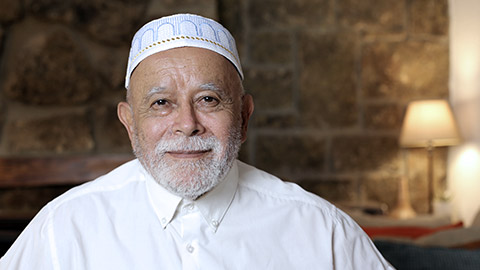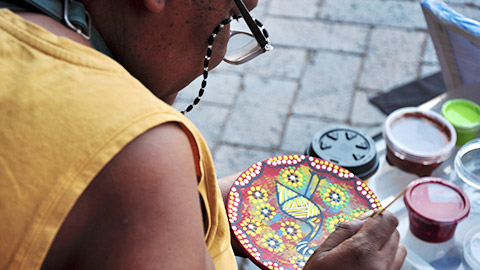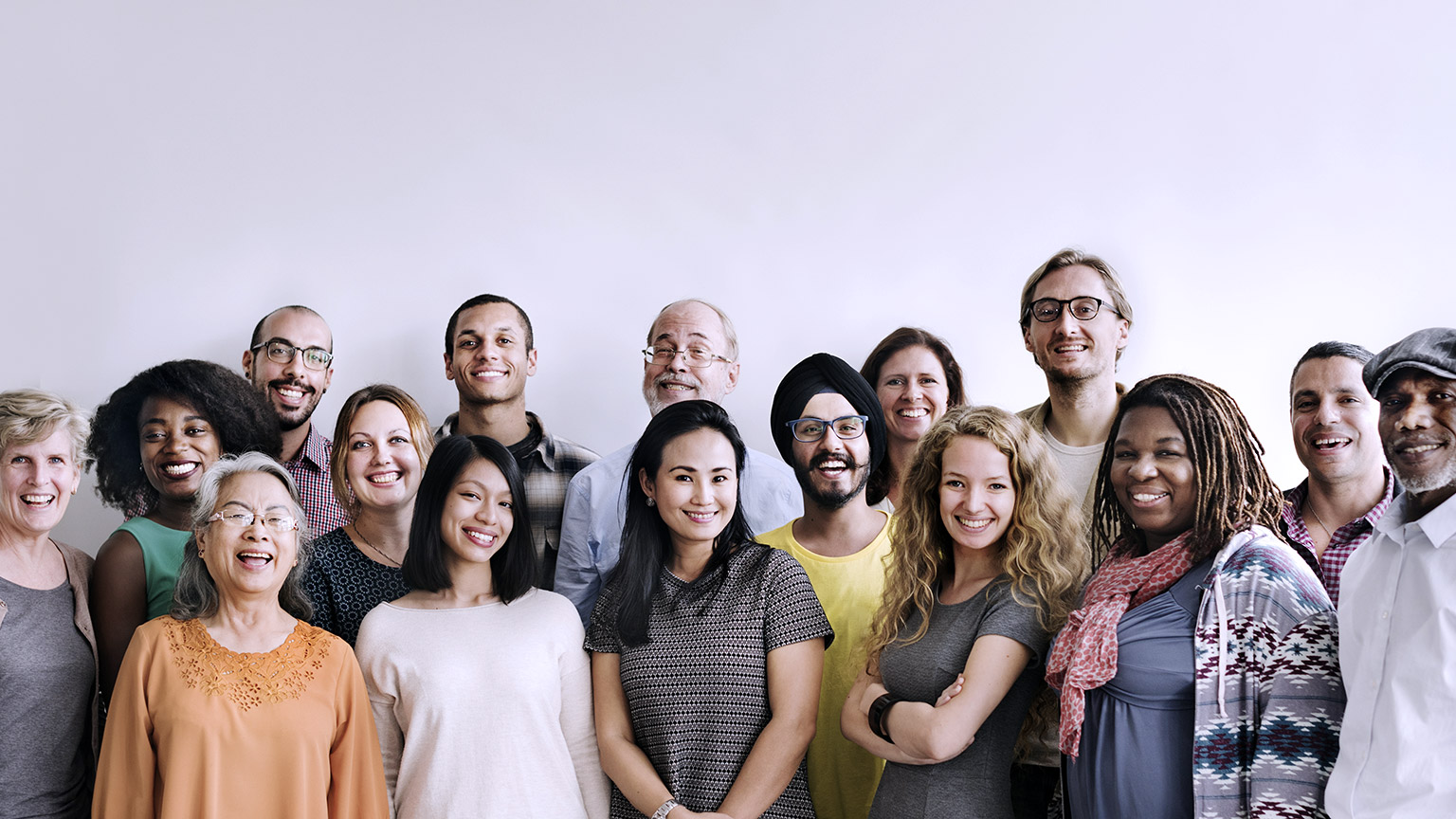Australia is a very diverse and unique country, with people from many different countries and backgrounds living here. In this unit, you will learn about diversity and how it relates to your work in community services settings with people of all ages and from many different backgrounds.
So what exactly is ‘diversity?’
Diversity can include gender, language, ethnicity, cultural background, age, sexual orientation, religious belief and family responsibilities. Diversity also refers to other ways in which people are different, such as educational level, life experience, work experience, socio-economic background, personality, marital status and abilities/disabilities.ACT Public Service (2010), Respect, Equity and Diversity Framework, p17.
Community services settings often include people from a diverse range of backgrounds, and it is vital that you have the knowledge and skills to work effectively and with understanding of individual differences.
Living in Australia, it is easy to simply assume that everyone knows a great deal about cultural diversity and is already able to work effectively in groups and workplaces which include people from many diverse backgrounds and cultures. However, working in a diverse setting can be challenging sometimes, and can take some practice and effort to master. Sometimes it is useful to step back for a moment and consider exactly what we mean by terms such as ‘cultural diversity’. How does it affect our day to day interactions at work; the tasks we carry out, the interactions we have and the decisions we make? By thinking about and planning effective diversity actions and responses, we can ensure our workplaces are able to operate at their best, for everyone involved.
Australia is a diverse community, and our diversity continues to grow and develop over time. Amongst our 24 million strong population, we are home to people who identify with over 270 different ancestries as well as the oldest continuous living culture. By 2016 there were 649,171 people who identified as being of Aboriginal and/or Torres Strait Islander origin (91% of whom identified as being of Aboriginal origin).
In the period since 1945, over 7 million people have migrated to Australia (Australian Human Rights Commission, Face the facts – Cultural diversity, accessed Nov 14 2019). According to the Australian Bureau of Statistics, over one quarter of Australians were born overseas, and a further 20% had at least one overseas born parent (ABS, Cultural diversity in Australia, accessed Nov 14, 2019.
Evolving cultures
Cultures do not stay the same; they are constantly evolving and changing. These changes happen as different generations of people grow up within a culture and adapt it to suit the world around them. Sometimes this can cause conflict or challenge, within families and in the broader community. People who have grown up in one country and then moved to Australia may feel differently to their children who were born here. In turn, their children may have experiences and feelings which are quite different to those of their parents.
Think
Where did you live ten years ago? What words would you use to describe it? Now reflect on where you live now (this may or may not be the same country or place). What differences do you notice? How would you describe where you live now?
Understanding diversity
Diversity is a difficult concept to define. Think for a moment about what the word ‘diversity’ means to you. Can you write your own definition?
Diversity refers to differences and variations which exist within a group, and is often used when talking about people who are from different cultural backgrounds. In fact, diversity refers to many characteristics:
Embracing diversity and seeing it as a positive part of Australian society can help create more harmonious relationships between people and groups.. In a community services setting, you are likely to work alongside people from a diverse range of backgrounds. You will also work with clients and carers who are from many different backgrounds, both in direct support roles and in the links you make with family members, caregivers and advocates.
Diversity at work
Ensuring a workplace is a positive, inclusive and welcoming place for everyone to be is not something that happens just by accident. There needs to be deliberate, planned activities and frameworks in place which ensure that:
- Australian and state / territory laws are respected
- Cultural awareness and understanding is achieved
- Diversity is embraced and welcomed
- Diversity is seen as a positive attribute of the workplace
- The workplace goes above and beyond what is legally required
People can be thought about as being ‘diverse’ in many ways – political, social, cultural and economic. Diversity simply means the many ways people are different and unique. Some of the most fundamental differences include:
Concept
First Languages Australia recommends using the term ‘language’ in all situations, rather than using terms such as ‘dialect’ or ‘creole’ as these tend to be used less accurately by many people.
Research
Go online and learn more about the Aboriginal languages which are spoken throughout Australia by visiting the website for First Languages Australia. Find out how to contact a local language group in your area and add their contact details to your personal resources file.
Diversity across the generations

Many community services settings include people from different age groups. We know that people who are from different age groups may approach tasks and learning experiences quite differently, and may have very different sets of values and ideals. A diverse range of ages in a workplace can contribute a great deal to overall team performance and achievement of business outcomes. Many workplaces utilise the experience and knowledge of older workers as a useful tool for supporting younger workers and providing them with guidance, mentoring and support.
Unfortunately, some workplaces, and community groups and settings, struggle to adequately accommodate and value older people. Discrimination can and does occur which makes it more difficult for older people to find a new job if they become unemployed. Some older community services workers are discriminated against when they apply for promotions or access to other opportunities. Some clients may find their age is a barrier to participation in some community based activities or events.
Diversity in politics
The Australian government, and the state and territory governments, are designed to represent the views, values and needs of the communities they serve. However, the Australian federal parliament is not representative in terms of its actual make up:
- Around 35% of seats across the lower and upper houses are held by women
- Less than 2% of seats across the lower and upper houses are held by indigenous Australians
- 10% of seats across the lower and upper houses are held by people who were born overseas
Think
If you were creating a parliament that truly represented Australia, what would it look like? Who would be a part of the lower and upper houses of parliament so that it really reflected the Australian community?
Blakkarly, J, Australia's new parliament is no more multicultural than the last one, SBS Investigations https://www.sbs.com.au/news/australia-s-new-parliament-is-no-more-multicultural-than-the-last-one, accessed 11/12/19
Diversity parameters
Diversity can apply to many different aspects of Australian society, and can mean different things to different people. Some parameters of diversity are included in the table below:
| Culture, race and ethnicity |
The cultural, racial and ethnic background of a person. This can relate closely to linguistic and cultural characteristics, such as the language spoken at home and the country in which someone was born, their family origins and the country to which they have close ties. For example, a client who identifies as Thai on an application form, and ticks a box to request an interpreter for face to face meetings. |
|---|---|
| Disability |
The presence or absence of a disability such as physical, cognitive, sensory or mental health condition. For example, a community services advocacy worker who is a wheelchair user. |
| Religious or spiritual beliefs |
Whether someone holds religious or spiritual beliefs such as being Jewish, Catholic, Christian or Buddhist. For example, a youth worker who runs a Christian Youth Club on a Friday night. |
| Gender |
Whether someone identifies as being male, female, transgender or non-binary. For example, a community services manager who updates an application form for a program to better reflect diverse gender choices. |
| Intersex |
People who are born with any of several variations of sex characteristics. For example, a community health program which develops a peer support group for people born with variations in sex characteristics. |
| Generational |
Age group or generational group, such as being Generation X or Y, or a Baby Boomer. For example, an outreach program which provides services to clients ranging in age from 0-5 years through to 55 plus years. |
| Sexual orientation |
Whether someone identifies as being lesbian, gay, bisexual or heterosexual. For example, a community centre which participates in an annual Pride Festival. |
There are many factors which influence diverse communities of people in Australia. Some of these factors relate to changing demographics within Australia, while others relate to legislation and acceptance and understanding of different cultural practices and ways of life. Some impacts can relate to social, political and economic factors.
Influences on diverse communities
Prior to the arrival of white settlers in Australia, there were already many diverse groups of people who lived across the country. For over 60,000 years, there were a large number of different social, tribal and language groups of Aboriginal people who lived throughout Australia. The years post 1788 saw movements of groups of people from a range of countries who came to live in Australia, initially either as convicts or free settlers. Many of these early arrivals were from the United Kingdom, and they were soon joined by migrants from other countries including China and Europe as events including the Gold Rush of the mid to late 1800s, World War 1 and 2, and the Vietnam and Korean Wars had an impact on the movement of people around the world.
Influences on diverse communities included:
- Circumstances related to their reasons for migration, such as seeking refuge or arriving on a temporary protection visa
- Experiences in their home country
- Maintenance of traditions and customs from home country
- Relationship between first and second generation migrants
- Acceptance of changing views and values over time
- Desire to relate to people from within own cultural or language group
- Desire for new ways of life and changing cultural practices
Often there was an uneasy tension between the traditional ways of life and the desire to forge new customs and ways of behaving, and interacting with others. Sometimes conflict arose within family homes and in the broader community, as each new wave of migrants battled with maintaining dual identities and ways of life.
Social, political and economic factors

Changing aspects of diversity have affected many aspects of social, political and economic life in Australia. This table shows how each of these issues can have a practical impact on people in the Australian community, and how they can have a protective effect or can increase the risk of harm to a person.
| Issue Area | Description | Example |
|---|---|---|
| Social | Protective factors can relate to interacting with a diverse range of people in the community, learning to speak a common language and engaging with social and community events and networks. Risk factors can include social isolation, disengagement from networks, inability to communicate with others and pressure to conform to societal expectations. | Margueritte attends classes at the community centre to learn English and find out how to set up an Australian bank account and access health services. |
| Political | Protective factors include feeling represented by people who share a similar background or are from the same generation, and feeling that views, values and preferences are represented by elected members of parliament. Risk factors include feeling unrepresented, not being provided with accessible information and not being required to vote as an older person. | Mark feels unable to contact his local member of parliament because, as a young, gay man, Mark does not feel confident his views will be respected and welcomed by a politician who has been outspoken in his hostility towards members of the LGBTQI community. |
| Economic | Protective factors include being employed, having access to further education or training, being financially literate and having a family support network. Risk factors include being unemployed, homeless, living in poverty or having a history of bankruptcy or business failure. | Mel has recently left an abusive relationship and is now struggling to find affordable, secure accommodation which is close to her son’s school. |
Changing practices of diverse communities
Within a culture, people hold many different practices which are important to them and they may not share the same practices.. Just because two people have the same cultural background does not mean they will adopt or keep the same practices.
Practices which might change over time include:
- Changing availability of foods and eating customs
- Religious and spiritual activities
- Festivals and celebrations
- Different languages being spoken in schools, workplaces and in family homes
- Different views on democracy, government systems and laws
- Clothing and presentation
- Educational ideas, access to education and systems of teaching and learning
- The role of men and women in decision making practices with a family and wider community
Diversity practices and experiences have the ability to affect all aspects of a person’s functioning and experiences.
Here are some of the ways that diversity practices can affect a person who is living in Australia:
- Actions
- Daily tasks
- Communication
- Participation in activities in the community and workplace
- Access to services
- Communication (verbal and non verbal)
- Independence and autonomy in relationships
- Leadership
- Accountability
- Role of men and women
- Tolerance
- Acceptance of others
- Inclusive practices
- Belief systems
- Values and viewpoints
- Role of men and women
- Rights and responsibilities
- Bias and discrimination
- Acceptance, tolerance and inclusion
- Dress and behaviour
- Greetings and interactions
Example

Joe is a client who receives support from an outreach program. He is originally from Saudi Arabia and holds firm views about the role of men and women in society. He finds it challenging when he discovers his new case manager is a woman who is younger than he is.
Activity
Think about your own life and experiences. How does your culture affect your behaviour, interpersonal relationships, perception and social expectation of others?
News and social media
The way that people from diverse backgrounds are portrayed in the media can have a significant effect on their experiences. News and social media can promote a mostly positive or mostly negative image of people and communities, depending upon the imagery and language that is chosen. This can be rapidly shared through social media platforms and across news networks, perpetuating and reinforcing concepts of diversity with a wide range of people.
News and social media can have an impact on how diverse views and values are represented, and in who has access to information. Lots of our news content is online and this is often the best way to access information or updates. For people who are not capable users of technology, this can create a barrier to information which affects their ability to interact and participate in society. For example, some older people are less able to access social media platforms or stay up to date with news stories. This can mean they are less able to participate in forums, make political or social comments on the things that affect their daily lives, or make their views known on topics.
Activity
Take a look at the following Community Profile for Victoria and identify how many people speak another language other than English.
News and social media can portray people in particular ways, reinforcing negative stereotypes. For example, news stories about older people often use imagery such as an older woman walking with a walking frame or an older man playing cards or reading a book. News stories about people with a disability often portray them as ‘heroic’ or ‘battling’ their disability, rather than simply describing them in a way which accurately represents the situation in the story.
Activity
Go online and visit a social media platform of your choice. Select 5 online stories or images and rate them according to whether they depict cultural diversity in a positive or negative way. Discuss your findings with a partner or classmate.
Research
Choose a culture which interests you and research the practices which are a part of that culture. Find out how many people in Australia identify with that culture, and see what you can discover about the clothing, food, music, celebrations and rituals that are a part of cultural practices. Share your information with the class.
Issues affecting Australian Aboriginal and Torres Strait Islander cultures

There are many issues that affect people from Australia’s Aboriginal and Torres Strait Islander cultures. These include issues related to social, political and economic factors. Some factors are protective, while others are risk factors. Protective factors have a positive influence while risk factors are those which increase the chance of harm or negative outcomes.
This table shows you some of the issues which may affect people who identify as being Aboriginal or Torres Strait Islander:
| Issue Area | Description | Example |
|---|---|---|
| Social | Risk factors can relate to separation from family, trauma, isolation and access to services and facilities Protective factors include strong family and community bonds, shared belief system, customs and language. | At Milly’s school, all the students learn a traditional language and take part in a song writing and performance program to ensure her traditional language is retained and spoken regularly in her community. |
| Political | Risk factors include access to voting systems and processes, representation in parliament and indirect discrimination through laws and political processes. Protective factors include protection through federal legislation such as the Racial Discrimination Act (1975) and Disability Discrimination Act (1992). | Genna can’t get into a café because it has a heavy door and a step and Genna’s wheelchair can’t go up the step. She makes a complaint about access and discrimination and the café owner decides to change the entry to provide better access for all customers. |
| Economic | Risk factors include higher unemployment rate leading to increase in poverty, financial hardship and reduced access to affordable housing, education and services. Protective factors include specifically targeted programs and support measures and government payments, subsidies and programs. | Mick has been out of work for 18 months and has recently lost his small business. His anxiety has escalated and he is now on medication. He has become isolated from his friends and family. |
Stereotypes
A stereotype means having an idea about how someone will speak or behave based on your own views and values about their characteristics. Stereotypes can lead to discrimination, either directly or indirectly. For example, there is a stereotype about Aboriginal people, that they do not want to work or will refuse to take a job when one is offered to them. Addressing stereotypes is one of the challenges of working in community services.
Example

Barbara works in an outreach program for people who have a mental illness. One day, she visits a client who tells her she feels she is being discriminated against because of her background. The client is a Djargurd Wurrung woman and she says she has been denied access to a sporting group in her community. The reason she has been given is because the group is full, but she knows there are other non indigenous people who have recently been able to join the group. She tells Barbara the sporting group seems to hold the stereotypical view that Aboriginal women don’t play sport and join sporting groups.
Activity
Go online and read some news or social media stories about each of the following groups of people:
- Aboriginal or Torres Strait Islander People
- Older people
- People who have a disability
Make a poster showing some examples of stereotypes, bias or discrimination that you find online, as well as some examples where there is a good match between the images and headlines used and the story itself. Have a conversation with a colleague about what this activity has highlighted for you.
Many workplaces use trainers from outside the organisation to help build awareness and skills within their workforce to help them operate more effectively and appropriately. Many workplaces build cultural competence training into their Reconciliation Plan.
Concept
A reconciliation Action Plan is a written document. It is made by an organisation to explain how they will work to support reconciliation in Australia.
Learn more about Reconciliation Action Plans
Cultural competence training in relation to Aboriginal and Torres Strait Islander cultures can include:
- Information and perspectives about Aboriginal and Torres Strait Islander cultures
- Understanding of the impact of history and trauma
- Welcome to country and acknowledgement of country
- Meetings, discussions and interactions
- Messaging and building trust over time
- Building a competent workforce
- Terminology and effective use of language
- Embedding cultural competence into the frameworks, policies and actions of the workplace as a whole
- Addressing issues and challenges
Cultural competence training is best delivered by people who have the knowledge and skills to do so, and who know about issues and challenges which in your own local area.
Resource
Go online and find a provider of cultural competence training in relation to Aboriginal or Torres Strait Islander cultures. Download or read information on their website and share what you learn with your class.
Human Rights
The Universal Declaration of Human Rights is an important document which recognises the inherent human rights of all people, regardless of who they are or where they live. The declaration covers the right to free speech, the right to education, health, life, social and economic security, and human dignity. Australia ratified the convention in 2008, and was one of the first Western countries to do so.
Australia has a strong system of legal protection to protect their human rights.
Federal legislation
Federal legislation applies throughout Australia and protects the rights of people to be treated equally in their work, daily activities and within the broader community. Federal legislation includes:
- Equal Opportunity Act 2010
- Disability Discrimination Act 1992
- Racial Discrimination Act 1975
- Sex Discrimination Act 1984
These acts make it unlawful to discriminate against a person on the basis of actual or perceived age, gender, disability or race.
For example, a sporting club cannot deny access to a person because of their race or ethnic background. A restaurant cannot tell a woman she is not allowed to breastfeed a baby in public. These are both examples of discrimination.
Human needs and human rights
It can be difficult to decide what the differences are between ‘needs’ and ‘rights’. We often talk about ‘needs’ as being things like food, water and shelter. However, how do these things compare with something like education or access to communication technology? Are these needs or are they rights? Or do they fall somewhere in between?
In Australia, everyone has the same rights and these are protected by Australian laws. However, people often have quite different needs. One way of thinking about these needs is to use a framework called ‘Maslow’s Hierarchy of Needs’.
Maslow’s hierarchy of needs
Maslow’s hierarchy of needs is a tool used to describe the basic needs of all humans. It can be applied to work in community services and is a useful way of thinking about the supports and assistance that are offered to a client. Maslow’s hierarchy begins with the lowest levels and works upwards towards the apex of the pyramid. Maslow proposed that the lower levels must be filled first before the upper levels.
Think
How could Maslow’s hierarchy of needs apply to working with a client who is experiencing poverty, homelessness and social isolation?
Employers, workers and clients all have particular rights and responsibilities in the workplace. In the areas of diversity relating to culture, age, disability, sexuality and gender, there are many different rights and responsibilities which apply. For example, an employer has a responsibility to provide a non discriminatory workplace and a community services worker has a right to be treated with dignity and respect during a home visit.
Examples of rights in relation to diversity include:
- The right to be listened to and treated with respect and dignity
- The right to work and be in a workplace which accepts and values people as individuals
- The right to a strong system of policies and procedures which are communicated and enforced
- The right to appeal decisions, and have complaints heard and acted upon
- The right to work in a place which is free from bullying, harassment and intimidation
- The right to receive education and training regarding diversity and culture
- The right to attend to the requirements of cultural and religious practices
Examples of responsibilities in relation to diversity include:
- The responsibility to follow and comply with legislation, policies, procedures and directions from managers or supervisors
- The responsibility to behave and interact in a way which is polite, respectful and appropriate
- The responsibility to learn about the cultural and linguistic needs of a client and their family
- The responsibility to follow lawful instructions provided by a manager or supervisor
- The responsibility to work with clients in a way that is fair, equitable and respectful
Taking action
In a community services workplace, there is a lot that people can do to take action on diversity. This means doing more than simply following the laws. It means thinking about the positive steps that can go above and beyond what the law requires. For example, taking action could mean meeting with Aboriginal elders in your local community, visiting people in a place where they feel safe and comfortable or making connections with community leaders. There are many ways to take action in your own workplace.
Bullying in the workplace
Bullying is one type of action which can happen in a workplace which is definitely not OK!. Bullying involves systematic, repeated actions or words which harm, intimidate, belittle or degrade another person. Bullying is not acceptable in the workplace and immediate and effective action must be taken.
In Victoria, ‘Brodie’s Law’ was established in 2011 following the tragic suicide of a young woman following relentless bullying at her work in a café in Hawthorn. The law makes it a criminal offence to commit serious bullying in a workplace.
Watch
Go online and visit the website for Brodie’s Law Foundation. Find the video links and choose one or more videos to watch so you can learn more about how and why the law was established in Victoria.
Discrimination
Discrimination means making an unfair decision made based on a characteristic of a person, such as having a disability or being from a particular race or gender. In Australia, discrimination is against the law.. In a workplace, it is important that everyone understands discrimination laws and how they protect people from discrimination.
Direct discrimination is easy to identify, and often involves clear statements which show bias or preference of one group of people or individual over another.
Indirect discrimination is more challenging to identify.,. Indirect discrimination relates to systemic, large scale mechanisms that make it more likely that a particular person or group of people will be favoured over another. For example, indirect discrimination occurs when a person who has dyslexia is unable to respond effectively to a job advertisement which has been written in overly complex and abstract language rather than in straight forward, easy to read Plain English.
Indirect discrimination still infringes the rights of people in a workplace, and it should always be addressed.
Making changes in the workplace
Workplaces can use many different tools to reduce the discrimination or bullying. These includes:
- Policies – clear statements which identify appropriate and inappropriate behaviours and the position of the workplace as a whole, as well as who is responsible for actions
- Procedures – clear action statements about what to do in a situation
- Vision statements – overall direction and values of the organisation so that policies and procedures can link with what the organisation values
- Training –training and guidance to build skills and knowledge in areas where rights may be infringed or to increase awareness of the responsibilities of individuals and work teams
- Mentoring – support from a more experienced worker to provide guidance and direction to a newer worker while they are first learning their job
- Induction – the time when a new worker is learning about the workplace, where documents, policy frameworks and responsibility and accountability can be explained
Example

Melanie has just begun working for a disability support agency as an in home worker. She attends an induction program to learn about the policies and procedures of her job. She works alongside another, more experienced worker for the first week so she can learn ‘on the job’ skills before she begins visiting clients on her own.
Check your understanding.
- Go online and see if you can research your local area and find out how many cultural ethnic groups there are.
- Reflect and consider what diversity means to you
- How might you learn about another person's culture?
In summary, this unit has provided a comprehensive exploration of diversity and its relevance to work in community services settings in Australia. We have examined the various dimensions of diversity, including gender, language, ethnicity, cultural background, age, sexual orientation, religious belief, family responsibilities, educational level, life experience, work experience, socio-economic background, personality, marital status, and abilities/disabilities.
Throughout this topic, we have emphasized the importance of developing cultural competence and understanding individual differences when working with diverse populations. We have explored the impacts of diversity on communities and highlighted the significance of promoting inclusivity, equity, and respect for all individuals.
By delving into topics such as Australia as a diverse community, cultural competence, rights, and responsibilities, we have deepened our understanding of how diversity influences our day-to-day interactions, decision-making processes, and overall effectiveness in the workplace.
As professionals in community services, it is crucial to recognize and appreciate the diverse backgrounds and identities of the individuals we serve. By applying the knowledge and skills gained from this unit, we can create inclusive and welcoming environments that meet the needs of all community members.
Remember, embracing diversity is not just about compliance or political correctness; it is about fostering a sense of belonging, promoting social justice, and unlocking the full potential of individuals and communities. Let us carry forward the lessons learned in this unit and continue to work towards building a more inclusive and equitable society for all.
